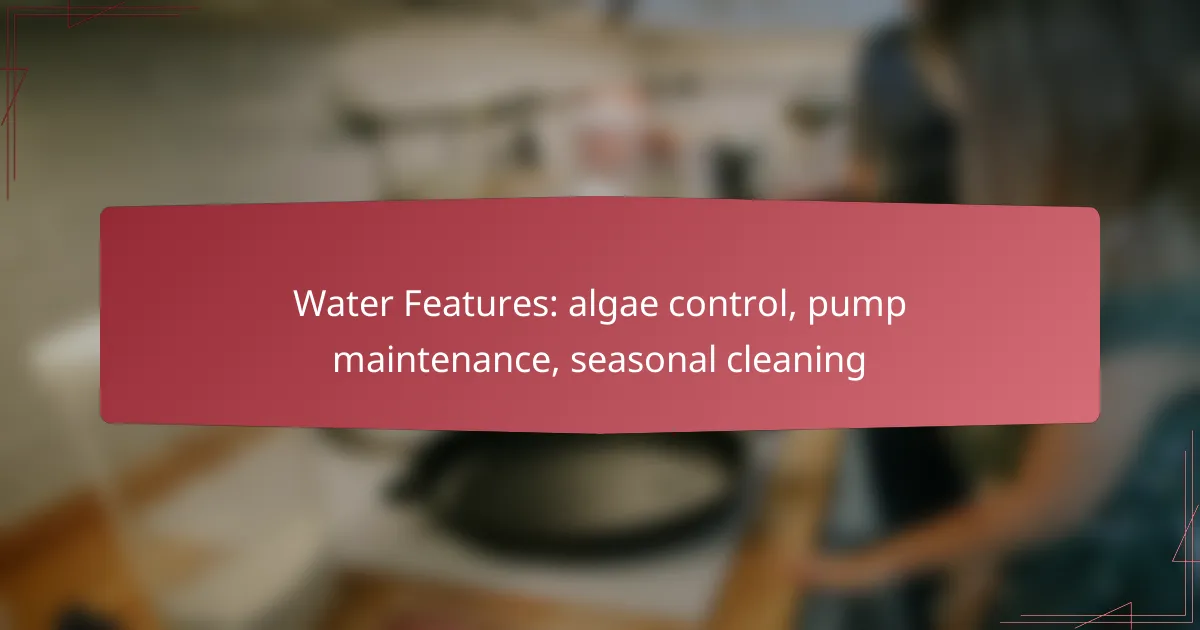Maintaining water features requires a proactive approach to algae control, pump maintenance, and seasonal cleaning. By implementing effective strategies such as using algaecides and ensuring proper water circulation, you can keep your water feature healthy and visually appealing. Regular inspections and cleaning of pumps are crucial for optimal performance, while seasonal cleaning helps maintain clear water and supports aquatic life. With consistent care, your water feature can thrive year-round.

How to control algae in water features in Los Angeles?
Controlling algae in water features in Los Angeles involves a combination of chemical treatments, physical maintenance, and biological methods. Effective strategies include using algaecides, implementing UV sterilizers, ensuring proper water circulation, regularly cleaning filters, and introducing beneficial bacteria.
Use algaecides effectively
Algaecides are chemical agents specifically designed to eliminate algae growth. When using algaecides, select products that are safe for aquatic life and follow the manufacturer’s instructions carefully to avoid harming fish or plants in your water feature.
In Los Angeles, consider applying algaecides during warmer months when algae growth is more prevalent. Regular monitoring of algae levels can help determine the right frequency and dosage for treatment.
Implement UV sterilizers
UV sterilizers use ultraviolet light to kill algae and other microorganisms in the water. By installing a UV sterilizer, you can significantly reduce algae blooms and improve water clarity.
Choose a UV sterilizer that matches the flow rate of your water feature. Regularly check the bulb’s effectiveness, as it typically needs replacement every 12 months to maintain optimal performance.
Maintain proper water circulation
Proper water circulation is crucial for preventing stagnant areas where algae thrive. Ensure that your pump is appropriately sized for your water feature and is functioning efficiently.
Consider adjusting the placement of fountains or waterfalls to enhance water movement. Aim for a circulation rate that refreshes the entire volume of water in your feature at least once every two hours.
Regularly clean filters
Cleaning filters is essential for maintaining water quality and preventing algae growth. Clogged filters can reduce water flow and create an environment conducive to algae proliferation.
Check and clean your filters at least once a month, or more frequently during peak algae seasons. Replace filters as needed to ensure they are working effectively.
Introduce beneficial bacteria
Beneficial bacteria can help control algae by outcompeting it for nutrients. These bacteria break down organic matter and improve overall water quality.
Incorporate beneficial bacteria products into your water feature during the spring and summer months for best results. Follow the recommended dosage on the product label to ensure effective treatment.

What are the best practices for pump maintenance?
Effective pump maintenance involves regular inspections and cleaning to ensure optimal performance and longevity. By following best practices, you can prevent malfunctions and extend the life of your pump system.
Inspect pump seals regularly
Regular inspection of pump seals is crucial to prevent leaks and maintain efficiency. Look for signs of wear, such as cracks or discoloration, which can indicate that seals need replacement.
Check seals at least once a month, especially in high-use seasons. Replacing worn seals promptly can save on costly repairs and water loss.
Clean pump intake screens
Keeping pump intake screens clean is essential for preventing debris buildup that can hinder water flow. A clogged screen can reduce pump efficiency and increase energy consumption.
Inspect and clean the intake screens every few weeks, especially during heavy debris seasons. A simple rinse with water can often remove most buildup, ensuring smooth operation.
Check electrical connections
Regularly checking electrical connections helps prevent pump failures due to power issues. Look for loose wires, corrosion, or damaged insulation that could disrupt the electrical flow.
Perform these checks at least quarterly. Tighten any loose connections and replace damaged components to maintain reliable pump operation.
Monitor water levels
Monitoring water levels is vital for pump operation, as running a pump dry can cause severe damage. Ensure that the water level is consistently within the recommended range for your specific pump model.
Use a float switch or water level sensor for automatic monitoring. Regularly check these devices to ensure they are functioning correctly, preventing potential pump burnout.

How to perform seasonal cleaning of water features?
Seasonal cleaning of water features involves a series of essential steps to maintain their appearance and functionality. Regular maintenance ensures clear water, healthy aquatic life, and efficient operation of pumps and filters.
Drain and scrub surfaces
Begin by draining the water feature completely to access the surfaces. Use a soft brush or sponge with a mild detergent to scrub the walls, floor, and any decorative elements, removing algae and dirt buildup.
After scrubbing, rinse thoroughly with clean water to eliminate any soap residue. This step is crucial to prevent harmful chemicals from affecting aquatic life once the feature is refilled.
Remove debris and leaves
Clear out any debris, leaves, or organic matter that may have accumulated in the water feature. Use a skimmer net or a vacuum designed for ponds to efficiently remove larger items.
Regularly removing debris helps prevent water quality issues and reduces the risk of algae growth, keeping the water feature healthy and visually appealing.
Check and clean pumps
Inspect the pump for any signs of wear or blockage. Disconnect the pump and clean the intake screen and impeller to ensure optimal performance. This maintenance helps prevent pump failure and prolongs its lifespan.
Consider replacing any worn parts if necessary. Regular checks can save you from costly repairs and ensure that water circulation remains efficient.
Test water quality
After cleaning, test the water quality using a test kit to check for pH, ammonia, nitrite, and nitrate levels. Ideal pH levels for most water features range from 6.5 to 8.5.
Adjust the water chemistry as needed to maintain a balanced environment for fish and plants. Regular testing helps prevent issues that can arise from poor water quality, ensuring a healthy ecosystem in your water feature.

What are the common algae types in water features?
Common algae types in water features include green algae, blue-green algae, and filamentous algae. Understanding these types is essential for effective algae control and maintaining a healthy aquatic environment.
Green algae
Green algae are the most prevalent type found in ponds and water gardens. They typically appear as a green film on surfaces or as floating clusters, thriving in sunlight and nutrient-rich water.
To manage green algae, consider reducing nutrient input by limiting fertilizer runoff and maintaining proper water circulation. Regularly cleaning surfaces and using aquatic plants can help compete for nutrients, minimizing algae growth.
Blue-green algae
Blue-green algae, or cyanobacteria, can produce harmful toxins and often bloom in warm, nutrient-rich waters. They may appear as a thick, green scum on the surface and can pose health risks to humans and pets.
To control blue-green algae, monitor nutrient levels closely and avoid over-fertilizing nearby gardens. Implementing aeration systems can improve water quality and reduce the likelihood of harmful blooms.
Filamentous algae
Filamentous algae form long, thread-like strands that can create unsightly mats in water features. These algae thrive in stagnant water and can block sunlight, impacting other aquatic life.
Regular maintenance, such as manual removal and the introduction of competitive aquatic plants, can help manage filamentous algae. Consider using a pond net to physically remove large clumps and improve water flow to discourage their growth.

How does weather affect water feature maintenance?
Weather plays a crucial role in the maintenance of water features, influencing factors such as algae growth, pump functionality, and overall cleanliness. Understanding these effects helps in planning effective maintenance strategies throughout the year.
Increased algae growth in warm weather
Warm weather creates ideal conditions for algae to thrive in water features. Increased sunlight and higher temperatures can lead to rapid algae growth, which may require more frequent cleaning and treatment to keep the water clear and healthy.
To manage algae effectively during warmer months, consider using algaecides and regularly checking water quality. Maintaining proper filtration and circulation can also help reduce algae buildup. Aim to clean your water feature at least once a week during peak summer months.
Freezing temperatures impact pumps
Freezing temperatures can severely affect the functionality of water feature pumps. When water freezes, it can expand and cause damage to the pump and plumbing, leading to costly repairs or replacements.
To protect your pumps during winter, consider draining the water feature and storing the pump indoors. If draining isn’t feasible, use a pond heater or aerator to keep the water from freezing completely. Regularly inspect your equipment for any signs of wear or damage before the cold season sets in.



